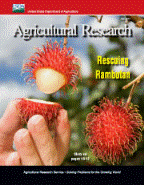United States Department of Agriculture: Agricultural Research Service, Lincoln, Nebraska

Agricultural Research Magazine
Date of this Version
4-2013
Document Type
Article
Citation
Agricultural Research April 2013
Abstract
With the climate changing and the world’s population expected to rise in the coming decades, supplying a hungry planet with food and fiber will become more of a challenge. By some estimates, food production will have to increase by up to 70 percent to feed the world over the next 40 years. Perhaps no resource is more critical to meeting that challenge than water.
How essential is water to agriculture? An estimated 17 percent of all harvested U.S. cropland is irrigated, accounting for about 56.6 million acres. Worldwide, more than 40 percent of the world’s food is grown on irrigated land, including the majority of high-market-value crops, such as fruits, nuts, and vegetables.
There is no doubt that drought is a continuing threat. At the peak of last summer’s record drought, more than 2,255 counties in 39 states were declared disaster areas, prompting U.S. Department of Agriculture Secretary Tom Vilsack to make $30 million in emergency funds available to struggling crop and livestock producers. By some estimates, the drought affected more than three-quarters of the nation’s corn and soybean crops. Economic losses are shared by livestock producers, who are forced to pay more for feed made with corn and other grains.
At the Agricultural Research Service, our drought-related research is based on the belief that if we understand the effects of drought on crops and habitats, we will be better equipped to address them. This issue highlights some of that research. On page 4, there is an article about research at the ARS Water Reuse and Remediation Research Unit in Riverside, California, to help growers tap into irrigation water that drains off crop fields in California’s San Joaquin Valley and reuse it to grow forage for livestock.
On page 6, you can read about work at the ARS Conservation and Production Research Laboratory in Bushland, Texas, to develop irrigation-scheduling tools for the Texas High Plains, where water levels in the Ogallala Aquifer are rapidly declining.
Researchers at the ARS Hydrology and Remote Sensing Laboratory in Beltsville, Maryland, have developed new tools that use satellites to assess soil water levels over large geographic areas. They’ve found that microwave and thermal radiative signatures of agricultural landscapes, detected by satellites, allow them to identify droughts earlier and collect more detailed information about their extent and severity. They shared the technology with the National Oceanic and Atmospheric Administration and other federal agencies, and it is being used to assist in quantifying drought conditions in the Horn of Africa.
ARS scientists are also using molecular tools at more than a dozen locations to identify genes in cotton, soybeans, wheat, and other crops that play key roles in determining drought tolerance. Their approaches range from using high-throughput phenotyping under drought conditions to DNA marker-assisted breeding techniques. Using molecular tools, researchers at the ARS Coastal Plains Soil, Water, and Plant Research Center in Florence, South Carolina, have discovered a family of genes in cotton that code for aquaporin proteins that function in plants as water-transport systems. Along with others discovered by the group, these genes are good candidates for improving cotton water-use efficiency.
ARS researchers in Ithaca, New York; College Station, Texas; and other locations are scanning the genomes of corn, wheat, and other crops, searching for genes that will prove useful in developing varieties with deeper roots and other traits that will help them grow with less water and under higher temperatures. At the ARS Soybean and Nitrogen Fixation Research Laboratory in Raleigh, North Carolina, scientists have developed and released the first-ever drought-tolerant soybean, which carries a gene that allows it to wilt more slowly than a normal soybean. Under drought conditions, slow-wilting types yield about 4 to 8 bushels per acre more than normal varieties and also show good yield potential when rain falls.
After many years of exploiting existing diversity within the genus Phaseolus (beans), ARS researchers in Mayagüez, Puerto Rico, have been able to combine genes for resistance to heat, drought, and disease and have released two highyielding, stress-tolerant black bean varieties; two heat-tolerant kidney bean lines; and rust-resistant, heat-tolerant common bean lines.
Included in
Agriculture Commons, Animal Sciences Commons, Food Science Commons, Plant Sciences Commons

